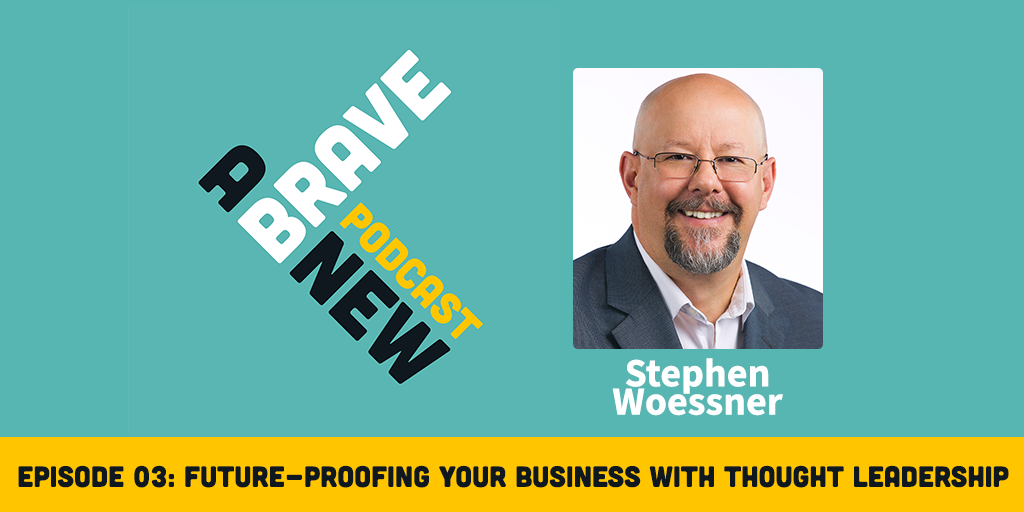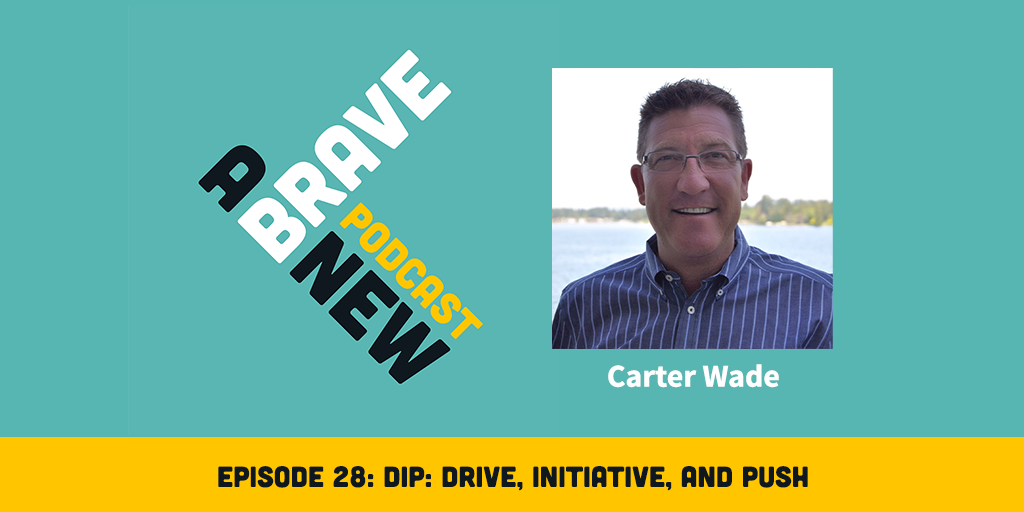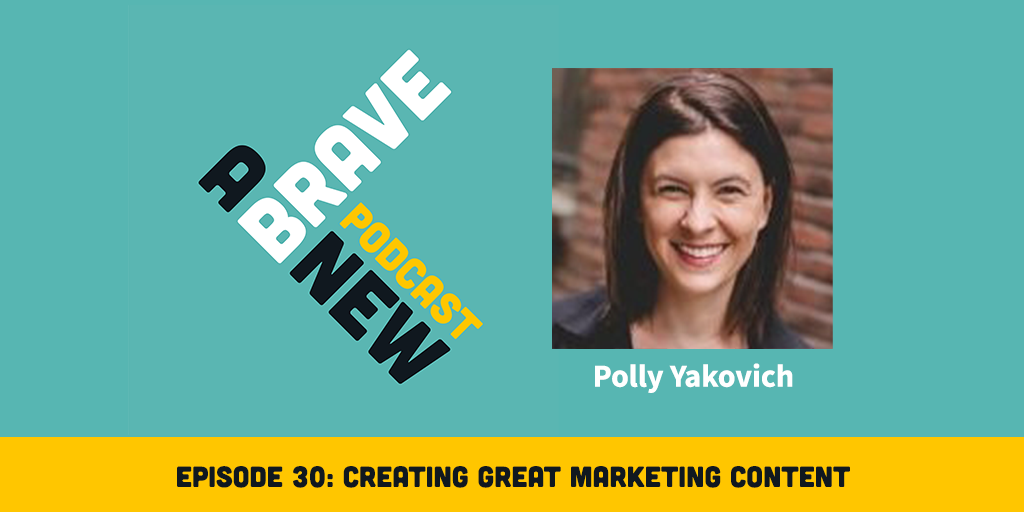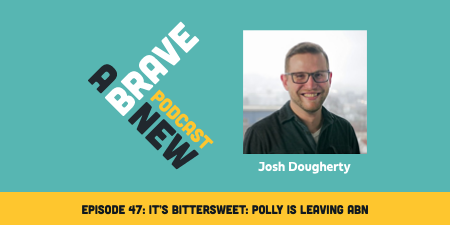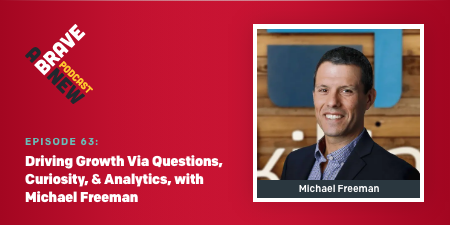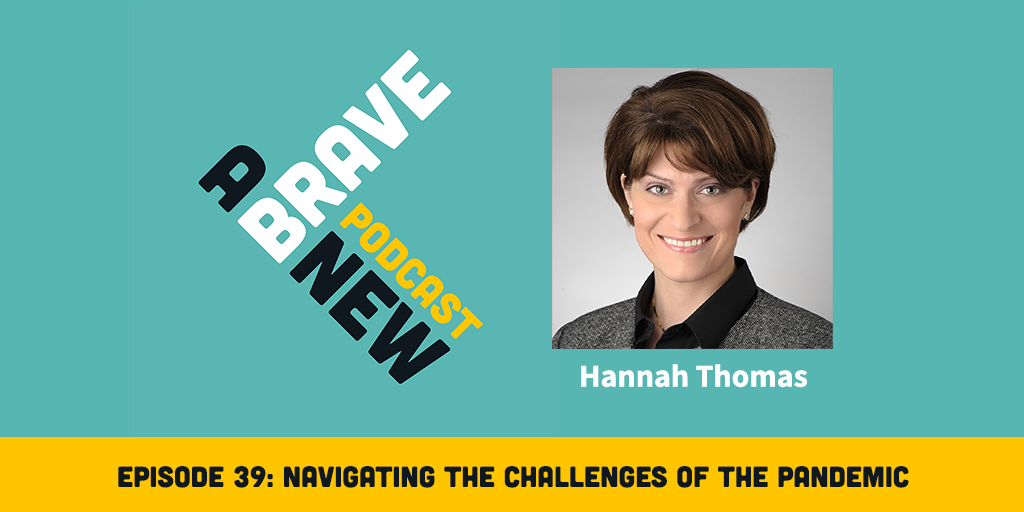Josh Dougherty is a brand strategist, speaker, and the founder and CEO of A Brave New, a Seattle-based B2B digital marketing agency specializing in tech and healthcare. Over the last decade plus, he’s worked with clients to develop unique brands and accelerate business growth using web design, inbound marketing, account-based marketing strategies.
What you’ll learn about in this episode:
- The benefits of building a developing a marketing strategy
- How strategy differs from tactics
- How to build a marketing strategy that thrives in disruption
- The importance of data and research
- How to structure your marketing strategy
- How to identify the right tech stack to deliver on your strategy
Additional resources:
- A Complete Guide To Developing A Marketing Strategy
- Josh Dougherty on LinkedIn
- A Brave New’s Website
Transcription:
Intro: Welcome to A Brave New Podcast, the podcast all about how big ideas, brave thinking, and marketing smarts, help businesses grow. Here is your host, Josh Dougherty.
Josh: Hello, and welcome to A Brave New Podcast. My name's Josh Dougherty, and I'm so excited to have you with me today. Today. I'm excited to take a step back and think about the concept of marketing strategy. How do you develop one? How do you build one out? Now, I think this is a really relevant conversation, whether you're just getting started out in your marketing career, or if you've worked in maybe a niche, maybe handling content marketing for an organization or handling some element of execution for an organization, and now you're trying to step up and just into a strategy role, or even if you are comfortable building out strategies, but you just want to kind of brush things up. So I hope there's something in here for each of you as we dive through. And before we dive into kind of my process for building out a marketing strategy, I'd like to talk a little bit about the benefits of doing this work, because I think often we think, "Well, couldn't we just dive in and we'll figure it out.
And we'll be okay and get along, and we'll figure it out as we go." And that can be true, but marketing, especially in the arenas that we're working in, in healthcare, B2B healthcare, enterprise technology, health tech, it's pretty complicated, and there's a lot of moving pieces. And so I think taking this step back is really helpful, because otherwise, you don't really know where the first step you should take is. Now, I was reading a statistic the other day that if a pilot takes off from LA and they're flying out to Boston, right? And they point the plane's nose maybe just a couple degrees off. If they do this, they could end up hundreds of miles off the mark. Maybe they land in Washington, DC instead of in Boston. And the principal is really the same here. When you're setting out to achieve your marketing goals, your KPIs that you have set for the year.
Maybe they're handed down to you from your boss, maybe they're co-developed, maybe they're dictated from the board, wherever they came from, you need to understand kind of where you're trying to go and how you want to get there if you want to be successful. And so that's really the first benefit of building out a marketing strategy, is this idea that you, by thinking in a disciplined way about where you're wanting to go and how you want to get there, you can know at least what the next step is to take as you're setting out to do implementation. And as you build out that roadmap, you have a really clear picture of where you're going, you know kind of the next steps you're taking as you walk down this path towards those goals, the next benefit really comes along. And this is that idea that you know when and how to pivot.
Because if you know where you're headed, you know what your underlying philosophies of how you're going to get there are, you're going to be able to understand and pick apart and draw out and really know, "Hey, we're starting to get stuck here, or maybe we've taken a left turn and we're not going to get to our destination, or maybe we're going straight and we need to pivot and go around an obstacle rather than to try to go straight through it." The documented strategy of what you're trying to achieve, how you're trying to achieve it allows you to determine when those pivots are necessary, because it gives you a pretty clear picture of when you're headed off course. And then the third, and maybe final big benefit of this process of building on a strategy, putting it down on paper is this, we all know that marketing programs take time to build momentum. They're a little bit like a freight train, right? Get going, it's going to take a lot of torque, it's going to take a lot of power, it's going to take up a lot of will to get things going.
We feel this when we're starting out with our marketing program. Maybe if it's not from scratch even, but we're trying to start something new, you've got to add a lot of fuel to the fire and the right fuel to the fire to get moving quickly. And as the freight train gets up to speed and starts rolling and starts moving along, it gets this thing called momentum. It becomes easier to add another mile an hour to the speed, or another couple miles an hour to the speed. This is the exact same with marketing. We can build momentum when we move in a methodical way in the same direction. And so a comprehensive marketing strategy allows you to do that. Now, the other conversation that I frequently have with people as we get into this process of building on a marketing strategy is, well, how does a marketing strategy... How does the strategy actually differ from tactics? And only spend a second or two here, because I think it's important, but I think we all understand.
Really, I think this is born out of the fact that many people believe in a myth that all that matters is more activity, and we believe that in our day to day. I don't think actually most people believe that in their core. They know only the right activity is going to drive the results that they need, but it's easy to think, "Oh, I'm doing this tactic and that tactic and that tactic, and I'm pursuing all of them in a strategic way, and so I'm going to get to the end goal I want." And what the strategy I think helps you do is step up above those individual tactics, no matter how strategically they're approached, and really say, how do they all fit together? Where do all the pieces fit in? And when we think about a strategy, really, it's outcomes focused, and a focus on solving and the overall challenge or achieving the overall goal. It's more about philosophy about how we're going to approach these problems. And under each strategy, we should have a series of tactics of how we're going to achieve it, kind of what we're going to do.
And so I do encourage you to really try to separate those two things out as you're building a strategy. Another important thing I think to tackle here today is this concept of disruption in a constantly evolving and changing landscape, and how that impacts doing strategy. Is it still possible to build a comprehensive strategy? What I would say about that is, it absolutely is possible, and it's probably more important than ever, because this disruption can easily... How do I say this? It can easily throw us off, like the direction we're going. It can distract us. It can force us to look at things in a way that maybe isn't straight up and down. And so we need a comprehensive strategy to be thinking about, how do we stay on course through all the disruption? Now, things have changed, I think, a little bit where you could, maybe in the past, set a strategy and just roll with it and hope it works out. I think things are a lot more fluid today.
And so your strategy needs to be a lot more flexible. It needs to be able to say, "You know what, this thing changed. How do we pivot?" We saw this a lot through the pandemic, where people had a strategy and they really had to pivot. Those people who hung onto their strategy for too long ended up failing. And I think one of those stories that is really interesting from a pivot perspective is a farm that was out in San Francisco, and they made a ton of money often doing these corporate retreats where people go to come and learn about sustainability. They'd meet animals on the farm. They'd maybe do some work, do some gardening. And this was a pretty cool concept. But once the pandemic happened, they had a choice, because all of their in person events disappeared, right? And so what were they going to do?
They came up with a concept called goat to meeting, where you could Zoom in in your Zoom meeting, in your go to meeting, I suppose as well, one of their goats, started selling this. It was a massive pivot, but it allowed them to survive the pandemic. And on the other hand, you saw other businesses that just kept driving forward and trying to do the same thing. And they ended up just crashing on the rocks and not surviving. And so the pandemic is obviously a massive disruption. So maybe all the disruptions we face aren't this big, but it really illustrates the point that we need to embrace fluidity and flexibility and build strategies that aren't so monolithic that we aren't going to be able to pivot and change when it's circumstance or a situation changes that will force the necessities to change in order to be successful.
The other thing that I think is really important in an era of disruption that is really answered by a marketing strategy, but requires some intentional thinking, is in a disruptive landscape, really, it's more important than ever to know who you are, know what makes your brand special, know what makes you tick, know where you're willing to pivot, where you aren't willing to pivot, how far you're willing to go with an idea, when you need to dial it back in. All these things are so important, because once you understand the core of who you are and how you want to show up, you're going to know how to, I think, respond to disruption in a way that feels authentic, and it's going to allow you to succeed. So enough about the kind of philosophy and initial thoughts around what a strategy is, why it's important. Let's dive into actually building out the strategy. So the first place I like to start whenever I'm building out a marketing strategy is really in data and research.
There's two kinds of primary things I think about when I'm thinking about research. We'll talk about that first. One is really giving yourself the opportunity to stop and have conversations. So whenever I start a marketing strategy with someone, I'm going to say, I want to have as many conversations as possible. Maybe we'll do 20, maybe we'll do 30, maybe we'll do 40. Talk to customers, talk to past customers, talk to prospects, talk to people internally, talk to folks externally who may have a peripheral idea about who your organization is and what you do. Talk to partners, have conversations around what's effective, what makes the organization special, where are things... What isn't working? How does the process work? All these sorts of things. And this is the type of qualitative research, I think, that can really allow you to start identifying some eye level themes. Now, we need to validate what we're thinking about and hearing with data. But at the same time, you can get a real sense of where the things are broken or where areas of investment are, where you can make the biggest impact by having some conversations.
Now, you may ask what that structure of those conversations is. Typically for me, it's doing a series of 30 minute Zoom interviews with all the people that I want to talk to, spending the time to really capture their thoughts and ideas. And then we'll transcribe those interviews, and we'll put them in a spreadsheet, kind of overlaying each person's responses over the specific questions that we asked. We'll ask everyone the same questions, so we can at least have some discipline at looking at, what are the themes across those questions? What can we learn from them? And this provides a bit of a solid foundation from a qualitative perspective about what's working in the marketing program, how we're making an impact. Once we do that, we can step back and do the other type of research I like to do, which is auditing, really taking a step back and looking at everything that's been done, and looking at it in the context of data as well, to understand what messages have been successful, what tactics have been successful. Where have we seen the most impact? Where do we have the most opportunity for acceleration?
Just really allowing ourselves to get really intimately equated with the tactics and the results those tactics have brought in. Now, you may say, I understand this and I really have a deep understanding of what I've been doing, because I've been running the program. I still think it's nice to step back and take a look at the big picture, and I challenge you to do that. And then finally, there's data. Data must under guard any marketing strategy today. So what is the type of data I'm looking at? For someone who's like our customer, maybe in B2B healthcare, in enterprise technology, they're trying to drive qualified leads, hand them over to a sales team to close, what we're going to do first is we're going to look at the funnel, or the flywheel, if you want to talk about that. But how are people entering your ecosystem? And then how are they moving through the qualification stages, and finally getting to the sales team to actually work and hopefully close? I want to look at that first and identify any breaking points, see if anything's not working.
And then I'm going to look at the major kinds of categories of statistics and see what we can glean from there, where we can identify opportunity points. So I might look at website traffic and do a deep dive there. I might look at email performance and do a deep dive. I might look at social channels and do a deep dive. Regardless, what I'm trying to do in my data review is identify two things. First, I'm trying to identify those areas of weakness. Where are things not working well, so that we could maybe make a drastic change and make a big impact. So that's the first thing I'm looking for. And then the other thing I'm looking for is, where are things really succeeding that I can build on? If a real strength based approach to building out a strategy, right? Because if something's rolling already, let's think back to our freight train we talked about a little bit ago. If it's already rolling and moving forward, we should make sure that we are accelerating that, putting a little more effort there, driving more results.
And so I think you look for the things that are really broken, that you can make an immediate impact on, quick wins. And then also look at the stuff that is already rolling, that you can just add a little more fuel to the fire and you're going to see great results. So that's really the background research. Do those in depth interviews, do some comprehensive auditing of your program, and then look at the data. And then mash it all together and start percolating it with your team, thinking about it and thinking how all those pieces come together. Once you've done this background thinking, you're able to then get into actually structuring and building out your strategy. So I want to walk you through a five part framework that we typically use for building a strategy, and then talk about how we put it into action. So let's start unpacking this.
At the end of the day, as we're building out our strategy, we're trying to come up with an idea of what is the overall story we're trying to tell, and how we position the campaign or the marketing program or the message in the right way. And so, like I said, we try to look at this in quadrants. It's a five part strategy. So if you think about a square, run a line vertically through it and horizontally through it to make four equal pieces, I want to think about those four pieces first. In the top left, we have this idea of category, which is what sector are we in? You know what industry you're working in, and you want to do some deep thinking and some research and some thought process around where our sector is going? Where can we have the most impact? Once you start projecting forward into where the sector's going, you can understand who of your competitors is going in that direction, in which direction, where the gaps are going to be, where you can grow, and I think where you can grow with the least resistance.
So that's important first, top left. Think about your category, where your sector's going, where your industry's going. Next, I want to go to the top right of my little square and think about the audience. At the end of the day, marketing is only good if it connects with our audiences, right? So we want to understand and do some thinking about who we're talking to, how do we think they feel? What do they care about? What are their triggers? What are the things that keep them up at night? What are the factors that are going to drive a decision to come and work with you? And so really bill out those sketches. You probably already pulled together personas. They probably get you partially here, but make sure and double track, as you're building a strategy, do we have this to find? So that's the next pillar, the top right of our little square, but also the next pillar of our marketing strategy. Then we want to go down to the bottom right, and think about our product or our services that we're selling.
Take some time with your team to really build out what are the strongest assets in our services? What are the benefits? What are the functional benefits? What are the emotional benefits we provide? What are the things that set your product apart from everything else? Now, I'm talking about a unique value proposition a little bit here, but it's really what makes you truly different? Get a deep understanding of that. So we talked about the upper left quadrant category. Where's our industry going? Upper right quadrant, audience. What do they care about? How do they feel? What are they thinking about? Lower right quadrant, product. What makes our product special? And then finally, in the lower left, it's this idea of a brand. What memory are we creating in our customer's minds? How will they remember us? What will they think about us? What makes us special and unique?
So if we're able to then define the category, our audience, our product, our brand, then we can start thinking about, what is a cross section? Think of this as a massive venn diagram and start seeing where all these things intersect, and that's where your story is, the positioning for the campaign. And so you're going to look for those intersection points and say, "Here, this is interesting. Our audience wants this, and it's natural to our brand and it highlights our product's greatest strengths." And this is going to allow you to pull together a strategy that works really well. So once you've defined this all out, you kind of have the overall bones of the strategy, right? You have an idea of how you're trying to impact the industry, what you're trying to capitalize on. You have an idea of how you're going to connect with your audience. You know the value proposition that you're going to convey about your product, and you also know the uniqueness.
And you've wrapped this up into a bow. It is a story or a nice message you're going to use to convey your marketing message, right? And after you've done this, it's now time to go down and think about, okay, we have this overall story. We probably have objectives that we've received as well from our board, or from leadership within the organization, but now we're going to define out some objectives that you have for the marketing program. And so keeping this story involved, keeping the whole framework involved, we're going to say, what are four or five objectives for your organization that you aren't trying to achieve? Maybe it's achieving brand awareness at a new level, maybe it is tripling the number of leads that you're bringing in, maybe it's accelerating your time as a lead goes through from initially getting to know you to becoming qualified and being handed off to sales, any number of things. And then underneath that, looking at those objectives set, I would say choose five or six strategies, and I'm not talking about tactics, but overall strategies of, there are each of these objectives.
I'm going to choose five or six strategies that are going to help me meet that objective. Now that each of those strategies may have five or 10 things you're going to do underneath them, but you can start to find out, where am I going, and what are my overall areas of focus as I try to meet my goal? So now you have your overall framework. You have your story you're trying to tell. You have your objectives, the four or five objectives that are out going to help you achieve your goals, your strategies. We're now going to tie to each of those strategies. What is the key metric that we're going to use to measure if we're achieving what we want to achieve with that strategy? I think it's really tempting to say, "We want to look at these five, 10 metrics for each strategy," but the reality is most of us only make decisions on one or two, and so we should think through what are the most important metrics for each strategy and tie those in.
So now you've got a strategy, you've got metrics, you've got objectives, you understand your space, you understand your audience, you know how you're trying to show up in a unique way with your brand, and you also know what makes your product unique in the unique value proposition. That's a lot of meat. You can start building out the marketing program then. But the one thing I want to say here is, you need to... As you start building out your tactics and start layering in and saying, "Okay, we're going to work on these three strategies first, and then these three strategies next," I want you to really be thinking about flexibility and growth, and how do we evolve and iterate, because chances are, under each objective, you may have three, four strategies, but one of them is going to completely blow out and you're going to have to pivot, or one of them is going to really become super successful and you're going to want to pour more fuel onto that fire to be able to capitalize on the effectiveness of that strategy.
So a great way to do this is, as you're building on an implementation plan, really to plan things out in quarters. And as you kind of have... I already identified your key metrics. They are going to guide your success. You should really be looking at those metrics, maybe on a monthly basis, maybe internally, but in a really formalized way on the quarterly basis, to ask the big questions around, is this still the right direction to go? Are we going to accomplish what we want if we keep going in this direction? Do we need to pivot? Do we need to change? Do we need to adjust? And so really, that quarterly framework of always coming back and evaluating once a quarter, where you're going, is going to help you kind of create a strategy that's lightweight and flexible enough for the change and the disruption that we currently live in. So we've got a flexible plan, we know where we're going. The next question is, do we have the right software to be able to execute on this plan?
And the questions I would ask really to drive that are, one, are there any major process obstacles that we're going to face with our current marketing stack that's going to stop us from being able to effectively do this work? The next question I would ask is, does our marketing software or tech stack allow us to report back on those key metrics that we've identified? If the answer is yes, great. You're going to be able to... You could be off to the races, but perhaps you're going to have to reevaluate and add in a couple different pieces from a platform perspective, or from a software perspective to be able to report effectively, because we need to be able to see, on a near up to the minute or immediate basis, how our efforts are going and how we can adjust them. And so you need to make sure that you can pull that right data out from your system.
And generally, I think there's really six, probably five types of platforms that you need to think about, versus really a marketing automation platform, then a social media platform, something that'll allow you to advertising, content management platform that's going to allow you to manage your content, but also do some SEO work, and then a reporting platform. And you need to think about how all these things work together, and how we connect them together. And probably if your organization has some expert developers in it, or you're able to give some trusted partners that can help you build out some solutions, you should maybe consider going with something that's more of a best in class solution and having multiple solutions that are tied together.
But if you don't have that in house and you're thinking, "Man, I don't know how to draw correlation between my marketing automation and my social media and my advertising, and understand how are all these pieces working together and how are they improving my results?" I would recommend considering something from an all in one perspective, like a HubSpot, or a Marketo that allows you to really do some effective marketing, but be able to do it in a system that I think you can navigate more easily without developer skills. This is why I'm really high on HubSpot. It's why we're a HubSpot partner, because we think it allows you to really get into the nuts and bolts of marketing without having to have endless technical skills and be able to take advantage of things like AI and testing and personalization, all these things that are essential to marketing today, but do it without any real development skills. So you've got your strategy built, right?
You have your objectives, you have the specific strategies you're going to use to achieve those objectives, you've created a framework where you will be looking at results quarterly and iterating so that you never can, I think, lose out or lose your momentum, and now, we've chosen a tech stack. The final thing to do is to make sure that you're measuring the right things. I think I mentioned this earlier, but I wanted to come back to it because I think one of the most important elements of an effective marketing strategy is that it's tempting to look at all the little metrics. And I'm not saying there isn't a time and place for looking into all those little metrics, to be clear, but the temptation is to drown in the metrics. And what I'm going to encourage you to do is say…
For each of our strategies, for each of what we're doing, step back, say, "What is the one metric or the two metrics that's really going to tell us if we're achieving this strategy effectively?" And be disciplined about it. Don't allow yourself to say, "Well, we actually need to look at these 10 things," because looking at 10 things means you aren't going to be maybe seeing the one thing that you need to do to be successful. And so my final admonition to you is to really focus in here on the metrics and on measuring the right things. For email, measuring maybe just your conversion rate and your open rate. How well are we getting people in, and how well are we getting them to take the action that we want to take. For inbound marketing, top of the funnel blogging content, it may be, we're looking at page views, and we're looking at, are we driving people deeper in the site? So is our bounce rate too high? For things like premium content, it's going to be looking at downloads and maybe an extra layer of qualified downloads.
So you can see how you can kind of choose out the couple metrics that are going to be the most effective for you, and then use those metrics to guide how you're making decisions in that quarterly basis that we talked about earlier. So I think we've covered almost all of it. Let me give you a quick rundown. We're going to start out with discovery and research. We're going to do two types of research, or three types of research, really, in-depth interviews, qualitative interviews to understand what's working, what's not with current customers, past customers, your team, maybe even prospects. Also, do some qualitative, doing audit work to understand and step back and look at everything that you've been doing and see how it all fits together. Then we're going to use data to really dial in, pass the results to understand where weak points are and where we can accelerate things. Next, we're going to move into structuring out and building the marketing plan.
So we're going to use a four quadrant system that says one, where is my industry going? Two, what does my audience want? Three, what's unique about my product? Four, what's unique about me as a company? And then you're going to use that to build a comprehensive story. That can be the messaging north star for your program. And after you have that in place, you're going to then set up a number of key objectives, three or four key objectives, and align the strategies underneath those objectives. And each strategy will then have a set of tactics to achieve it. So with that framework in place, then you're going to dive into building out a flexible way to execute, building out your dashboards, building out all the work that needs to happen in such a way that you can look at stuff quarterly and make pivots quickly, on the fly. I think it's lightweight here, right?
So once you have that quarterly review cycle in place, you're going to dive in and figure out is my tech stack really able to support this? Do I need an all in one solution where I can do all this without having technical expertise? Do we have APIs that are set up correctly enough that we can actually manage our program and understand what's going on? These are questions only you can answer, but I encourage you to look at stuff like your marketing automation platforms, social media platforms, advertising, content marketing platforms,, reporting platforms. Figure out what your tech stack needs to be. Remember to trim it down, if possible. And so then, again, emphasizing. Make sure you measure the right things as you go down this road, and make sure you're constantly adjusting your north star back to the destination you want to go to so you don't end up like that plane flying from LA to Boston that accidentally lands in DC. So to close here, I want to talk about how you transition from strategy to implementation?
You've been thinking about the big picture, the story you're trying to tell. You've been thinking about strategies underneath it. You probably came up with an ungodly amount of work that you're not going to be able to accomplish all at once. And so my first admonition, before I let you go, is this idea of prioritizing. Prioritize what you're going to do first. Admit that you can't do it all, and start knocking things off one by one. The next thing I would say is that you need to measure at the end of execution. So you're going to act, and then measure, always remembering that measurement comes, really importantly, right after acting so that you can make sure that you're having the biggest impact. And you can understand when you need to add something new in, number three.
And the corollary to number three, cheating always with my numbers here, I know, is when do you stop doing something? So answer that. And really, as you're going through your process, you prioritize, you're acting, you're measuring, you're adding maybe something in new, you're removing it, always improving. And then you're going to repeat this process over and over and over again. And at the end of the day, your written marketing strategy is going to become a living, breathing marketing program that is moving towards the north star, which I think is a pretty great thing, and I think everything that we want to accomplish as people, as we're going the marketing process, because all of us want to think we're going to hit that end goal and we're going to do it successfully. So I hope this pod has really encouraged you to think deeply about how to build a marketing strategy, and also encourage you to get started. The best time to start is now, to get your strategies aligned so that you can be successful, and that you can drive breakthrough results for your company.
Now, if you want to dive into this topic more, I will have, shortly, or probably by the time you've listened to this, published a blog post around the same content. It's going to come complete with links for a bunch of other content that you can read, but please dive in if you want to take some time to learn a little bit more about marketing strategy. If you want to connect with me and talk about it too, you can look me up on LinkedIn, Josh Dougherty. I'm the CEO over at A Brave New, so pretty easy to find. And other than that, thanks so much for joining me today. I really appreciate your time, for listening. If you have enjoyed the episode, I really ask you to go and rate it, and give us a five star review on whatever platform you're listening on so that we can help get the word out about the podcast. And yeah, I hope I'll catch you next time. Have a good one. See you, everybody.
Outro: Thanks for listening to this episode of A Brave New Podcast. Go to abravenew.com for more resources and advice. If you enjoyed this episode, show us some love by subscribing, rating, and reviewing A Brave New Podcast wherever you listen to your podcasts.
Similar Articles
OCT 11, 2021

The Beginner’s Guide to Generating Inbound Leads
Marketing doesn’t have to be painfully intrusive, like getting yet another telemarketing call right when you sit down to dinner with your family.
OCT 11, 2021

The Beginner’s Guide to Generating Inbound Leads
Marketing doesn’t have to be painfully intrusive, like getting yet another telemarketing call right when you sit down to dinner with your family.


